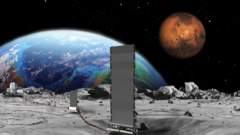NASA is racing to establish a nuclear power source on the Moon by 2030 to support long-term human habitation. This move comes as the United States positions itself in a rapidly intensifying international race for lunar dominance, characterized by initiatives from other nations like China and Russia, which are also eyeing sustained lunar presence. According to reports, the head of NASA has expressed concerns about potential territorial claims from these nations, which could lead to restricted zones on the Moon, ultimately impacting efforts for civilian exploration.
This ambitious plan is rooted in the necessity for reliable energy due to the Moon's unique day-night cycle, which complicates solar energy utilization. During the lunar day, lasting about two Earth weeks, solar energy might be viable; however, during the two weeks of darkness, continuous power is crucial for survival and operations. Achieving a nuclear reactor capable of producing at least 100 kilowatts of power could facilitate these needs, aiding both a possible lunar economy and Mars expeditions in the future.
NASA's call for partnerships with commercial firms marks a significant advancement in their Fission Surface Power Project, following previous contracts initiated in 2022. Yet, skepticism looms as critics point out the recent drastic budget cuts to NASA, which could slow progress on this project and other essential scientific endeavors.
Experts in the field remain cautiously optimistic. Some believe that the technical capability to deploy such reactors exists, contingent on renewed investment and robust collaboration within NASA’s Artemis program. However, safety concerns during the launch of radioactive materials remain prominent, needing to be addressed thoroughly before any implementation can take place.
The urgency in NASA's plans echoes historical precedents from the early space race, where pursuits for space exploration turned into national rivalries. Experts caution that a heavy focus on geopolitical interests could hinder broader scientific exploration ideals, emphasizing the importance of collaboration in the international arena regarding lunar operations.
Duffy's recent statements regarding potential territorial stakes highlight the need for clear agreements, like the Artemis Accords established in 2020, aimed at fostering collaboration among nations for lunar utilization. If positioning a nuclear reactor enables nations to claim portions of the Moon as operational safety zones, it could further exacerbate tensions in space governance.
As NASA aims for manned lunar missions by 2027, already facing multiple setbacks, the practicality and synchronization of efforts for building the necessary infrastructure for these nuclear capabilities remain a critical factor in realizing a sustainable human presence on the Moon.



















